Optimal Design of a BLDC Motor Considering Three-Dimensional Structures Using the Response Surface Methodology
Abstract
:1. Introduction
2. The 3D Structure and Its 2D Equivalent
2.1. Analysis Model
2.2. Magnet Overhang
2.3. Housing-Integrated Rotor
3. Design of Experiments (DOE)
3.1. Design Variables Affecting Cogging Torque
3.2. Factorial Design
3.3. Factorial Design with Center Point
3.4. Response Surface Method
4. Results
5. Conclusions
Author Contributions
Funding
Institutional Review Board Statement
Informed Consent Statement
Data Availability Statement
Conflicts of Interest
References
- Kim, S.H. Motor Control-DC, AC, BLDC; D.B.Info.: Seoul, Korea, 2017. [Google Scholar]
- Kai, Y.; Yaojing, F. Design of Novel Spiral Magnetic Poles and Axial-Cooling Structure of Outer-Rotor PM Torque Motor. IEEE Trans. Appl. Supercond. 2010, 20, 838–841. [Google Scholar] [CrossRef]
- Wang, Y.; Chau, K.T.; Chan, C.C.; Jiang, J.Z. Transient analysis of a new outer-rotor permanent-magnet brushless DC drive using circuit-field-torque coupled time-stepping finite-element method. IEEE Trans. Magn. 2002, 38, 1297–1300. [Google Scholar] [CrossRef] [Green Version]
- Tang, Z.-H.; Chen, Y.-T.; Liou, Y.-K.; Liang, R.-H. Axial Magnetic Force Analysis and Optimized Design for Single-Phase BLDC Slim Fan Motors. IEEE Trans. Ind. Electron. 2021, 68, 6840–6848. [Google Scholar] [CrossRef]
- Youssef, M.Z. Design and Performance of a Cost-Effective BLDC Drive for Water Pump Application. IEEE Trans. Ind. Electron. 2014, 62, 3277–3284. [Google Scholar] [CrossRef]
- Leitner, S.; Gruebler, H.; Muetze, A. Innovative Low-Cost Sub-Fractional HP BLDC Claw-Pole Machine Design for Fan Applications. IEEE Trans. Ind. Appl. 2019, 55, 2558–2568. [Google Scholar] [CrossRef]
- Lee, C.-M.; Seol, H.-S.; Lee, J.Y.; Lee, S.H.; Kang, D.-W. Optimization of Vibration and Noise Characteristics of Skewed Permanent Brushless Direct Current Motor. IEEE Trans. Magn. 2017, 53, 1–5. [Google Scholar] [CrossRef]
- Park, Y.-U.; Cho, J.-H.; Kim, D.-K.; Young-Un, P. Cogging Torque Reduction of Single-Phase Brushless DC Motor with a Tapered Air-Gap Using Optimizing Notch Size and Position. IEEE Trans. Ind. Appl. 2015, 51, 4455–4463. [Google Scholar] [CrossRef]
- Lee, T.-Y.; Seo, M.-K.; Kim, Y.-J.; Jung, S.-Y. Motor Design and Characteristics Comparison of Outer-Rotor-Type BLDC Motor and BLAC Motor Based on Numerical Analysis. IEEE Trans. Appl. Supercond. 2016, 26, 1–6. [Google Scholar] [CrossRef]
- Chun, Y.-D.; Lee, J.; Wakao, S. Overhang effect analysis of brushless DC motor by 3-D equivalent magnetic circuit network method. IEEE Trans. Magn. 2003, 39, 1610–1613. [Google Scholar] [CrossRef]
- Shin, H.-S.; Shin, K.-H.; Jang, G.-H.; Cho, S.-K.; Jung, K.-H.; Choi, J.-Y. Experimental Verification and 2D Equivalent Analysis Techniques of BLDC Motor with Permanent Magnet Overhang and Housing-Integrated Rotor Core. IEEE Trans. Appl. Supercond. 2020, 30, 1–5. [Google Scholar] [CrossRef]
- Chun, Y.; Wakao, S.; Kim, T.; Jang, K.; Lee, J. Multiobjective Design Optimization of Brushless Permanent Magnet Motor Using 3D Equivalent Magnetic Circuit Network Method. IEEE Trans. Appl. Supercond. 2004, 14, 1910–1913. [Google Scholar] [CrossRef]
- Kim, K.-C.; Lee, J. The dynamic analysis of a spoke-type permanent magnet generator with large overhang. IEEE Trans. Magn. 2005, 41, 3805–3807. [Google Scholar] [CrossRef]
- Kim, K.-C.; Koo, D.-H.; Lee, J. The Study on the Overhang Coefficient for Permanent Magnet Machine by Experimental Design Method. IEEE Trans. Magn. 2007, 43, 2483–2485. [Google Scholar] [CrossRef]
- Jolly, L.; Jabbar, M.; Qinghua, L. Design optimization of permanent magnet motors using response surface methodology and genetic algorithms. IEEE Trans. Magn. 2005, 41, 3928–3930. [Google Scholar] [CrossRef]
- Rao, K.S.R.; Bin Othman, A.H. Design optimization of a BLDC motor by Genetic Algorithm and Simulated Annealing. In Proceedings of the 2007 International Conference on Intelligent and Advanced Systems, Kuala Lumpur, Malaysia, 25–28 November 2007; pp. 854–858. [Google Scholar] [CrossRef]
- Han, K.J.; Cho, H.-S.; Cho, D.-H.; Jung, H.-K. Optimal core shape design for cogging torque reduction of brushless DC motor using genetic algorithm. IEEE Trans. Magn. 2000, 36, 1927–1931. [Google Scholar] [CrossRef]
- Li, J.; Liu, Z.; Jabbar, M.; Gao, X. Design Optimization for Cogging Torque Minimization Using Response Surface Methodology. IEEE Trans. Magn. 2004, 40, 1176–1179. [Google Scholar] [CrossRef]
- Park, J.; Kim, S.; Hong, J.; Lee, J. Rotor Design on Torque Ripple Reduction for a Synchronous Reluctance Motor with Concentrated Winding Using Response Surface Methodology. IEEE Trans. Magn. 2006, 42, 3479–3481. [Google Scholar] [CrossRef]
- Fang, L.; Jung, J.-W.; Hong, J.-P.; Lee, J.-H. Study on High-Efficiency Performance in Interior Permanent-Magnet Synchronous Motor with Double-Layer PM Design. IEEE Trans. Magn. 2008, 44, 4393–4396. [Google Scholar] [CrossRef]
- Si, J.; Zhao, S.; Feng, H.; Cao, R.; Hu, Y. Multi-objective optimization of surface-mounted and interior permanent magnet synchronous motor based on Taguchi method and response surface method. Chin. J. Electr. Eng. 2018, 4, 67–73. [Google Scholar] [CrossRef]
- Im, Y.-H.; Hwang, S.-I.; Choi, J.-Y.; Jang, S.-M.; Choi, J.-H. Analysis of Torque Pulsation Considering Interior Permanent Magnet Rotor Rib Shape Using Response Surface Methodology. IEEE Trans. Magn. 2012, 48, 979–982. [Google Scholar] [CrossRef]
- Kim, S.-I.; Hong, J.-P.; Kim, Y.-K.; Nam, H.; Cho, H.-I. Optimal design of slotless-type PMLSM considering multiple responses by response surface methodology. IEEE Trans. Magn. 2006, 42, 1219–1222. [Google Scholar] [CrossRef]
- Lee, B.-H.; Hong, J.-P.; Lee, J.-H. Optimum Design Criteria for Maximum Torque and Efficiency of a Line-Start Permanent-Magnet Motor Using Response Surface Methodology and Finite Element Method. IEEE Trans. Magn. 2012, 48, 863–866. [Google Scholar] [CrossRef]
- Koh, C.S.; Yoon, H.S.; Nam, K.W.; Choi, H.S. Magnetic pole shape optimization of permanent magnet motor for reduction of cogging torque. IEEE Trans. Magn. 1997, 33, 1822–1827. [Google Scholar] [CrossRef]
- Islam, M.; Mir, S.; Sebastian, T. Issues in Reducing the Cogging Torque of Mass-Produced Permanent-Magnet Brushless DC Motor. IEEE Trans. Ind. Appl. 2004, 40, 813–820. [Google Scholar] [CrossRef]
- Hendershot, J.R.; Miller, T.J.E. Design of Brushless Permanent Magnet Machines; Motor Design Books: Venice, FL, USA, 2010. [Google Scholar]
- Hwang, S.-M.; Eom, J.-B.; Hwang, G.-B.; Jeong, W.-B.; Jung, Y.-H. Cogging torque and acoustic noise reduction in permanent magnet motors by teeth pairing. IEEE Trans. Magn. 2000, 36, 3144–3146. [Google Scholar] [CrossRef]
- Zhu, Z.Q.; Howe, D. Influence of design parameters on cogging torque in permanent magnet machines. IEEE Trans. Energy Convers. 2000, 15, 407–412. [Google Scholar] [CrossRef] [Green Version]
- Garroi, J.-J.; Goos, P.; Sörensen, K. A variable-neighbourhood search algorithm for finding optimal run orders in the presence of serial correlation. J. Stat. Plan. Inference 2009, 139, 30–44. [Google Scholar] [CrossRef]
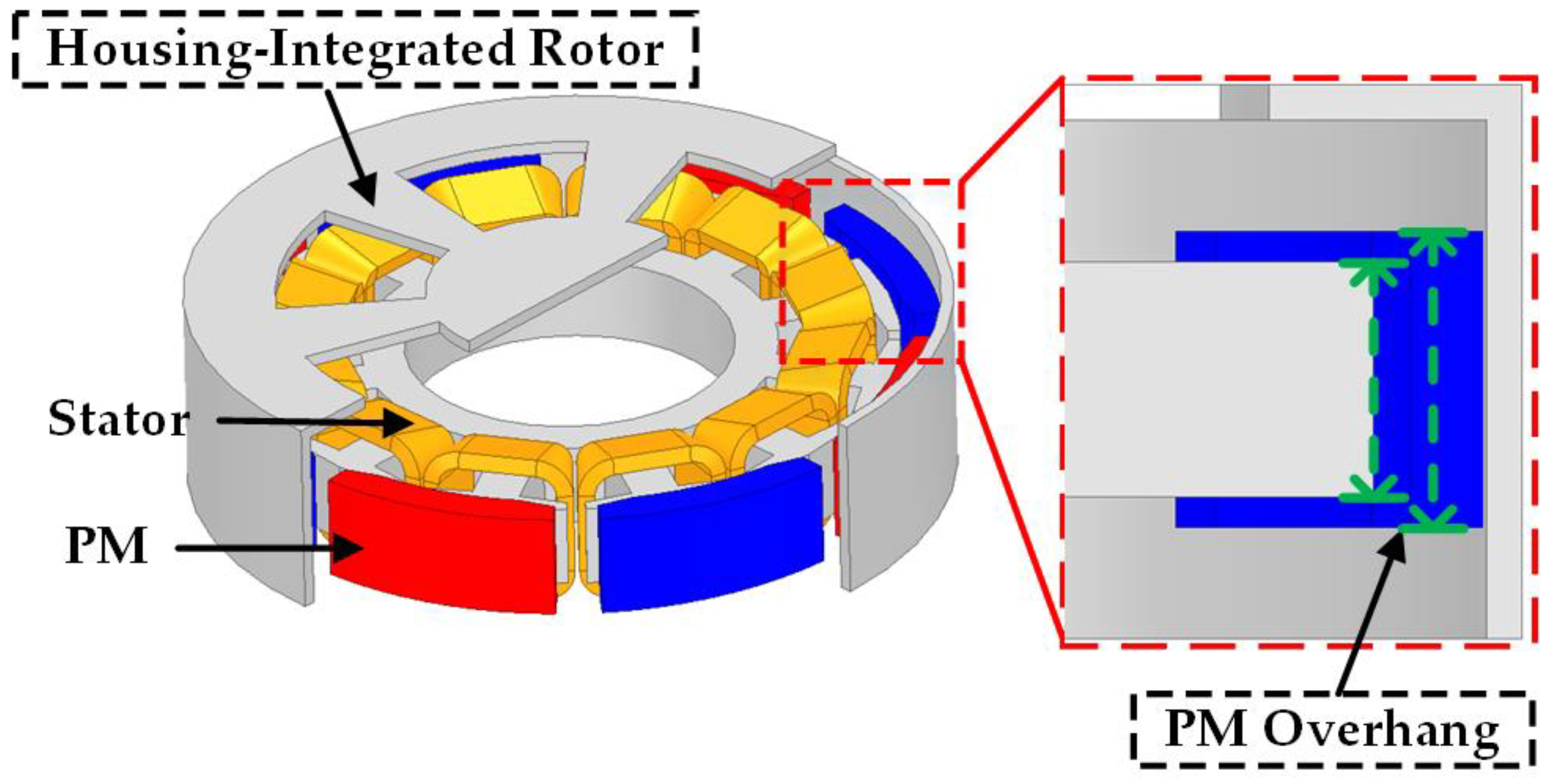
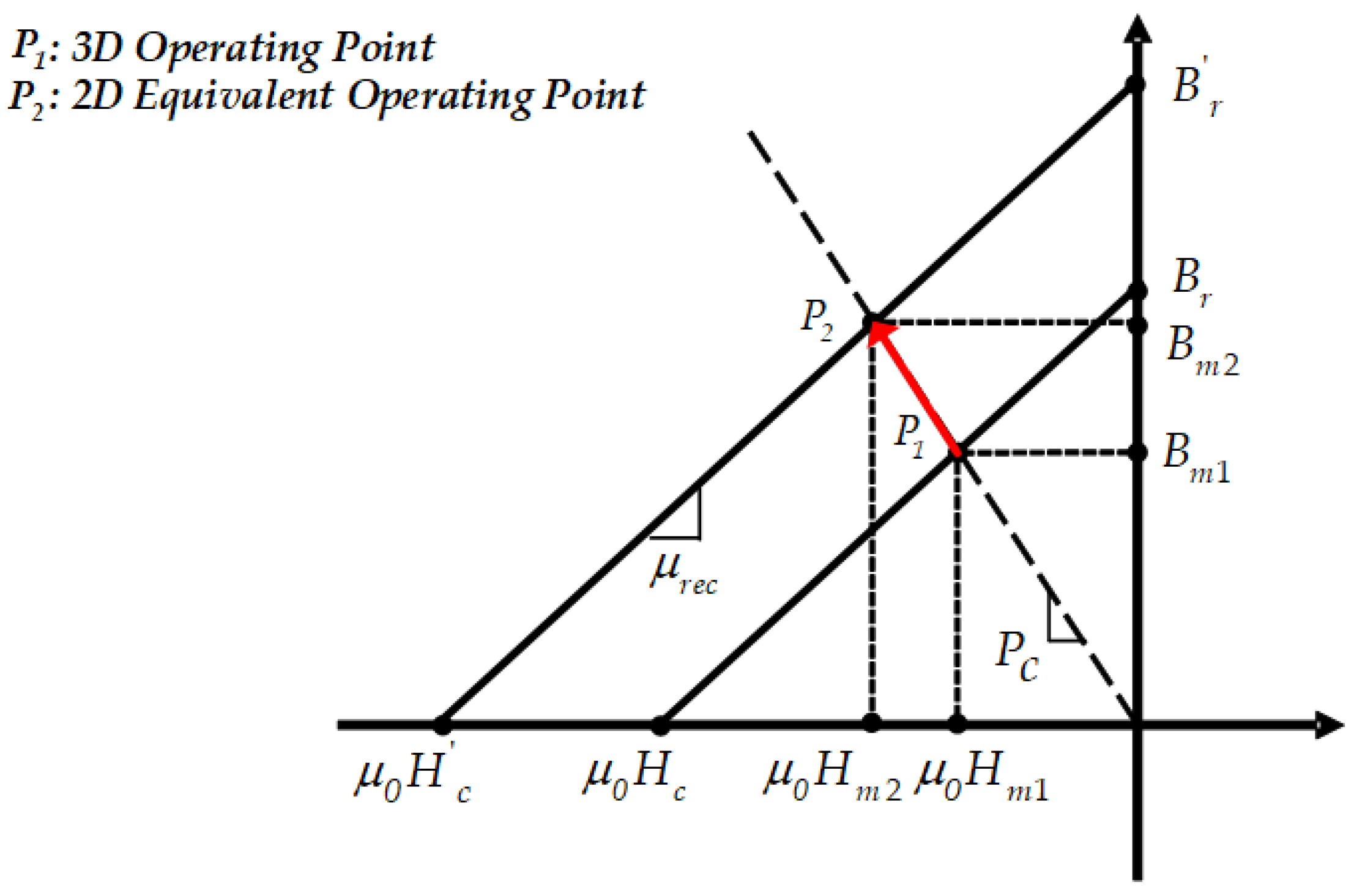
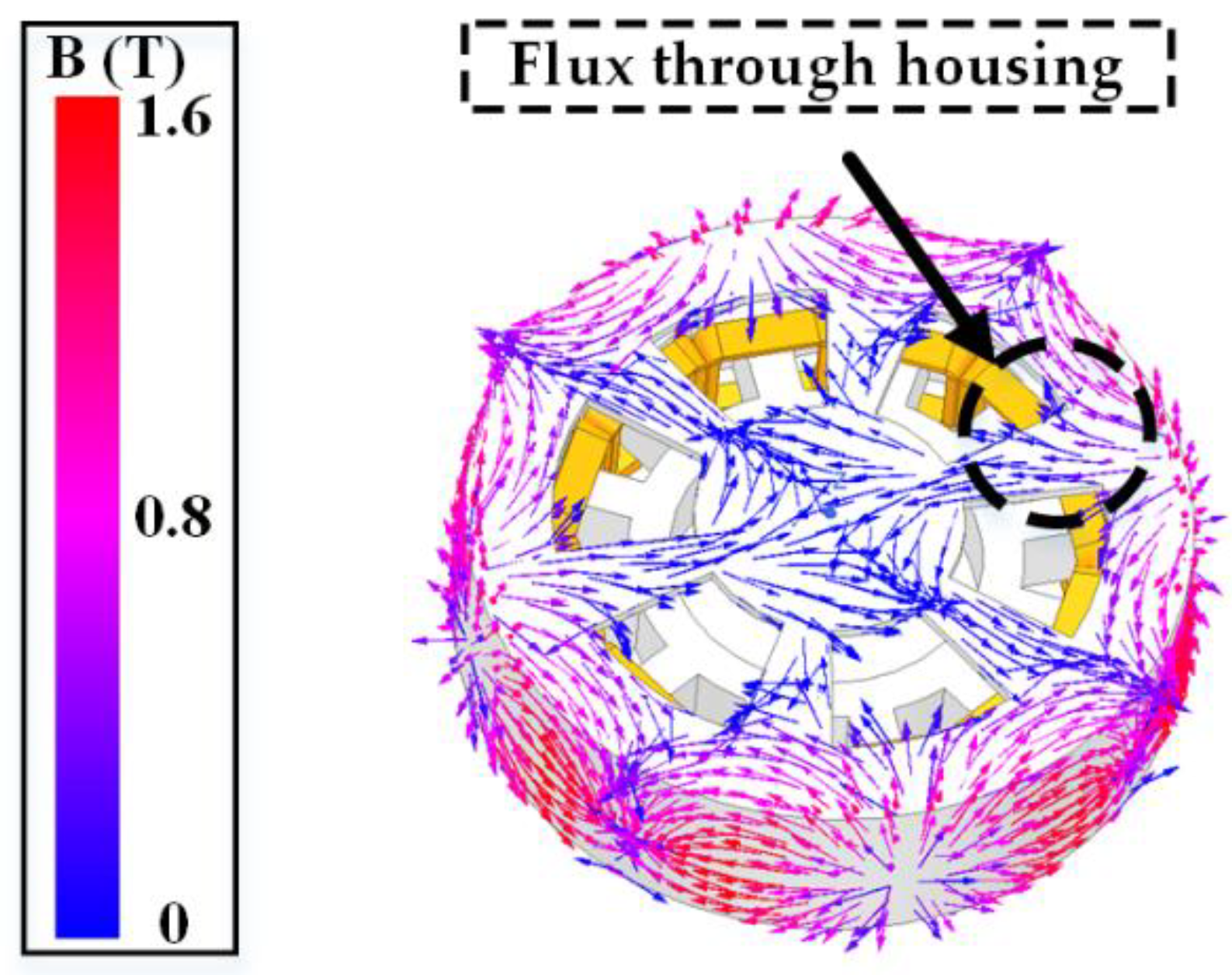
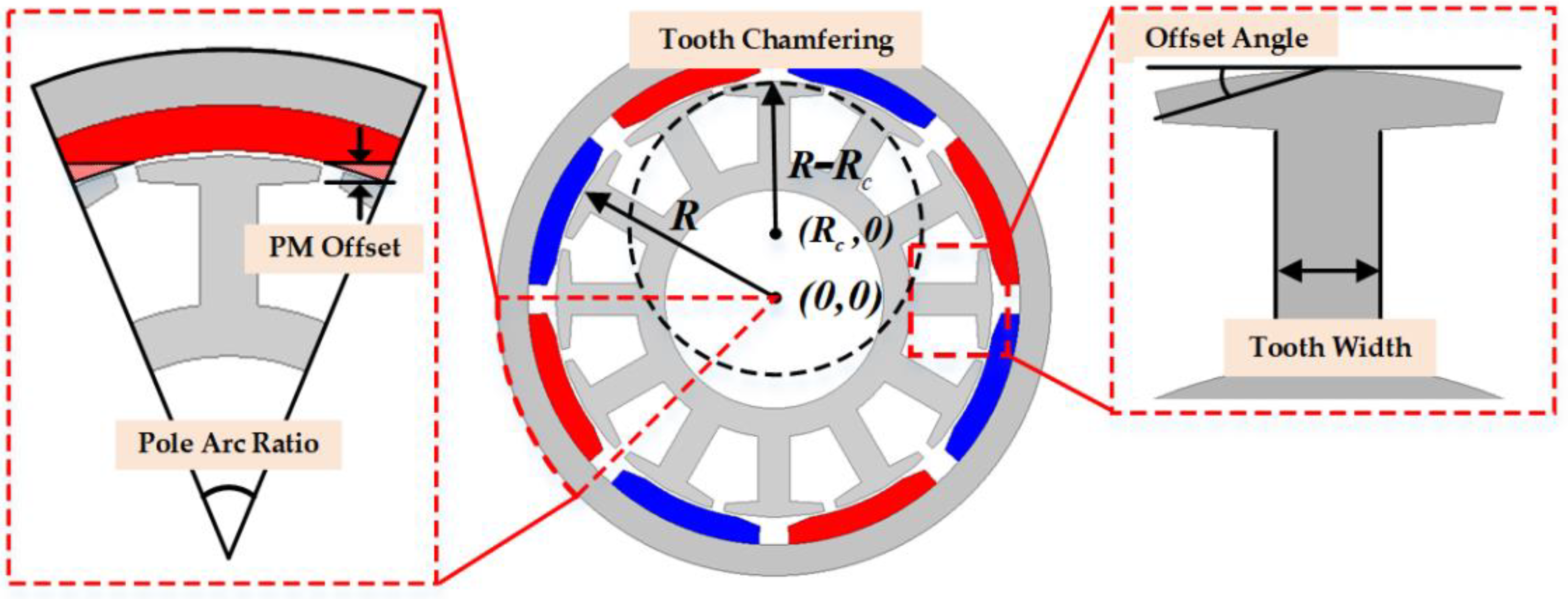
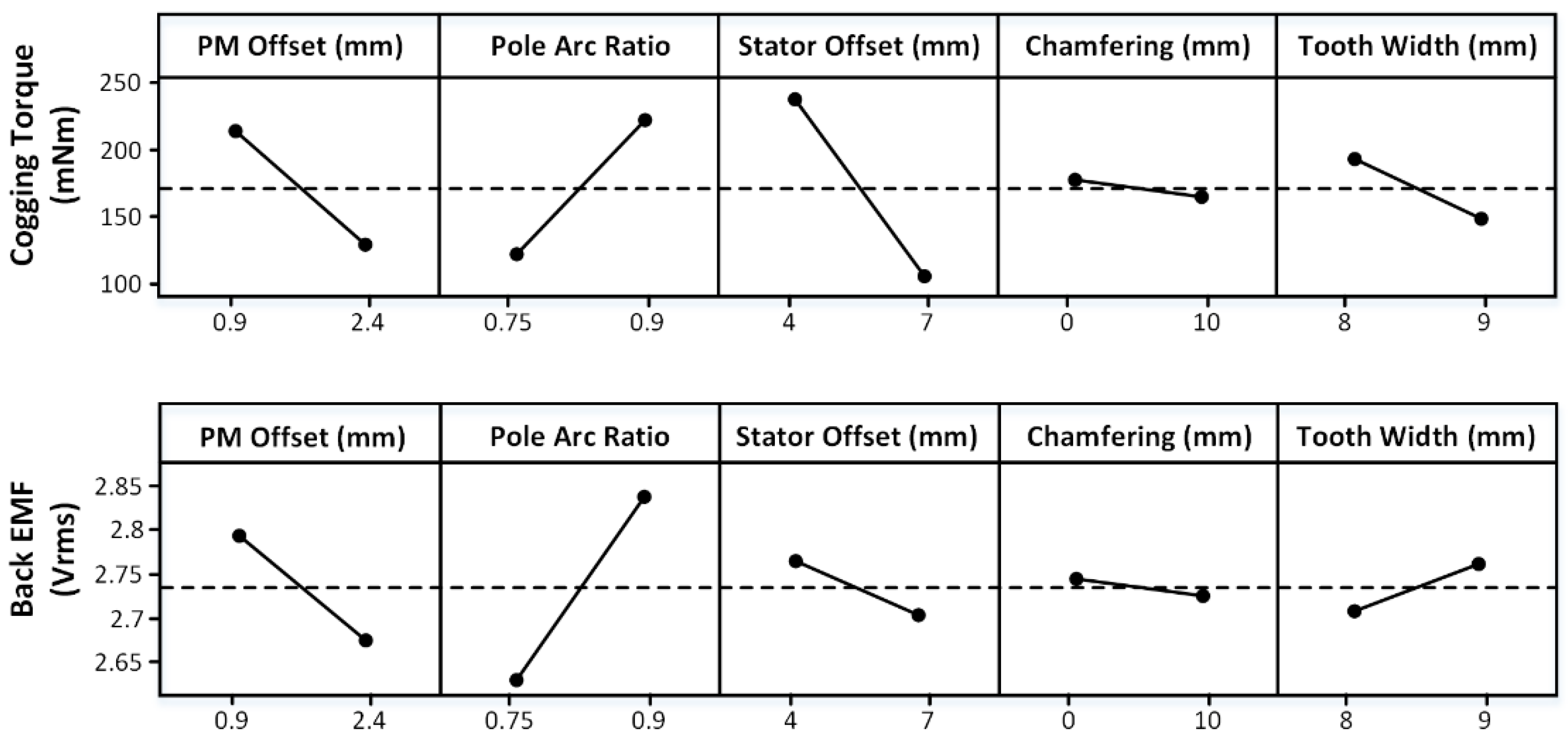
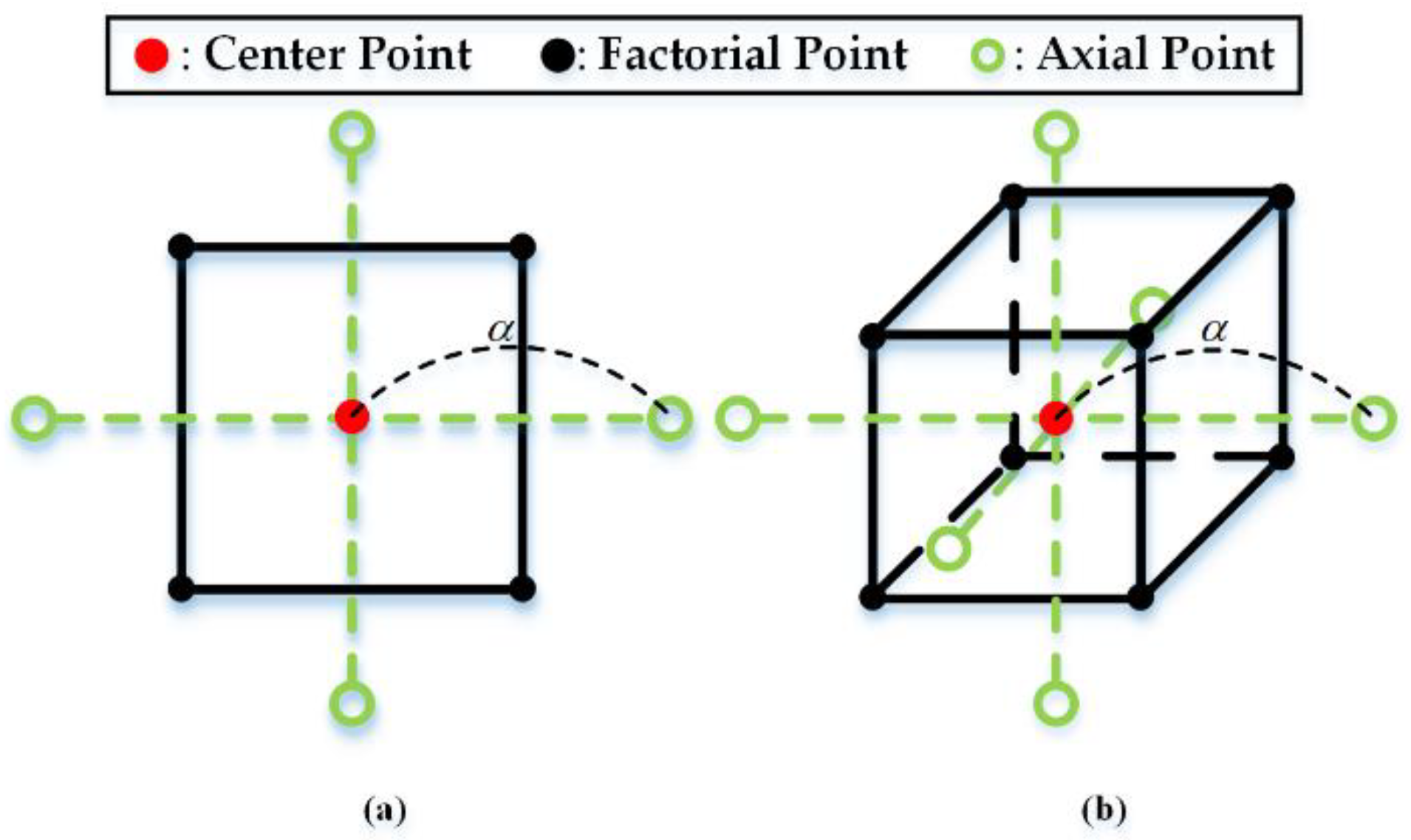


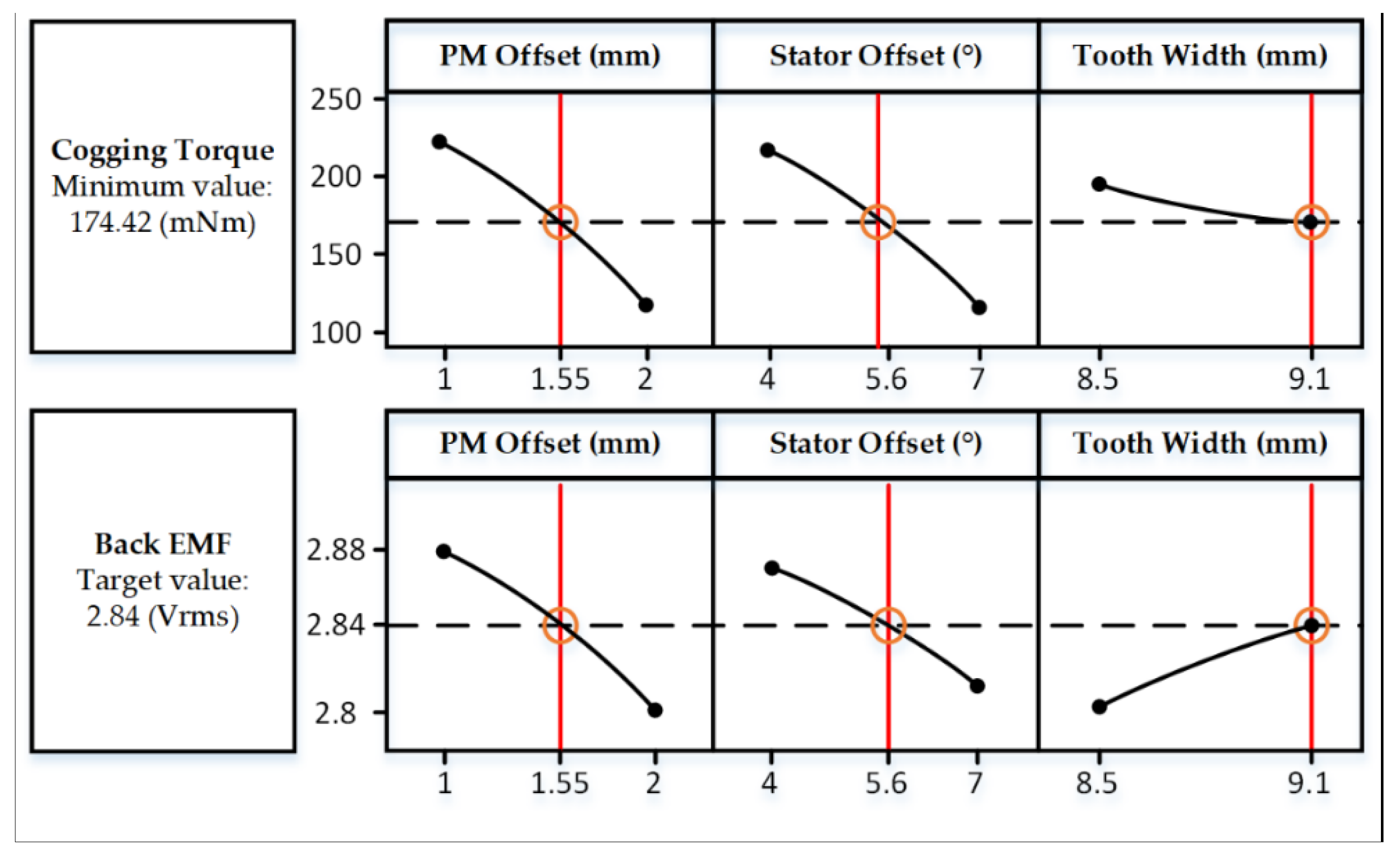
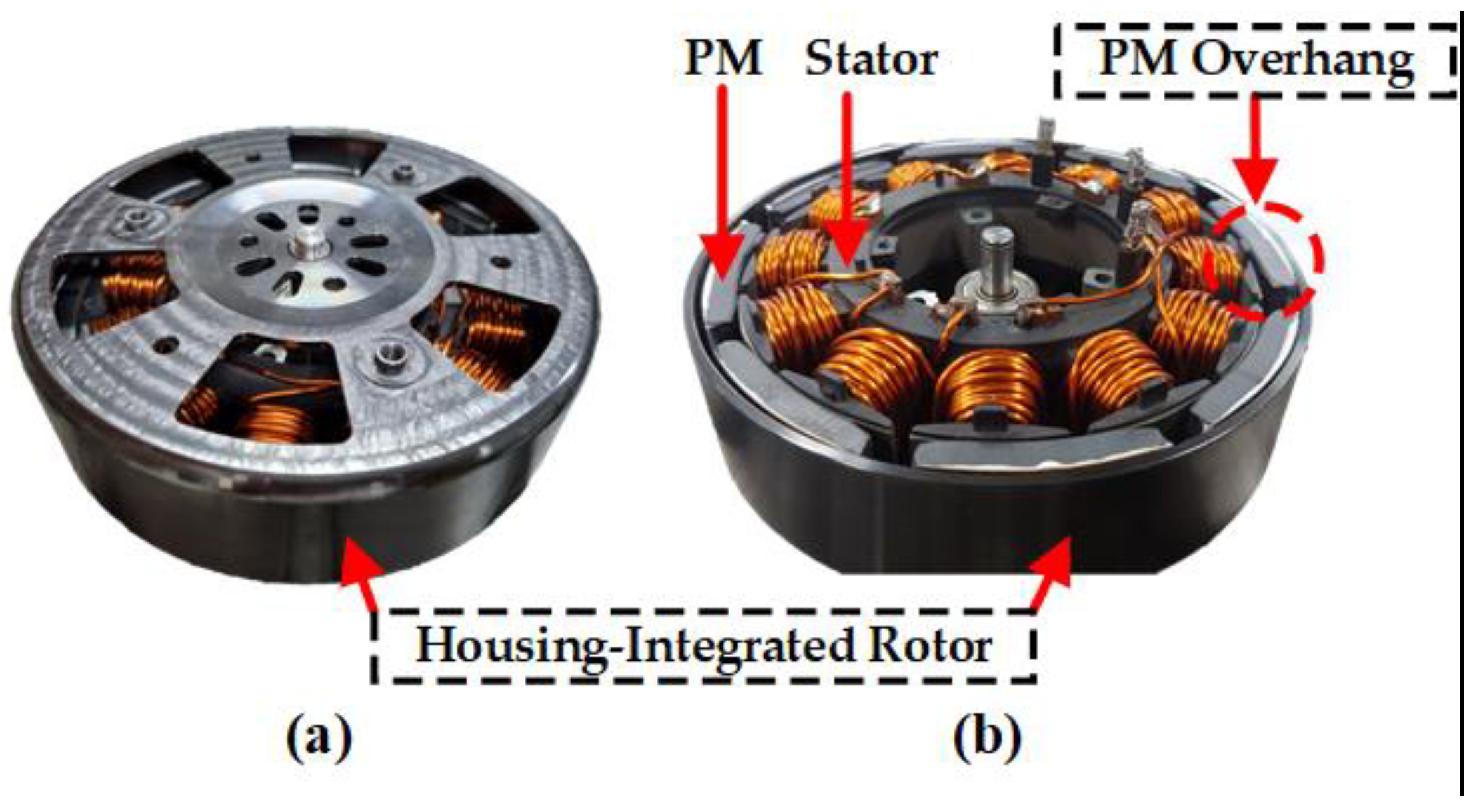
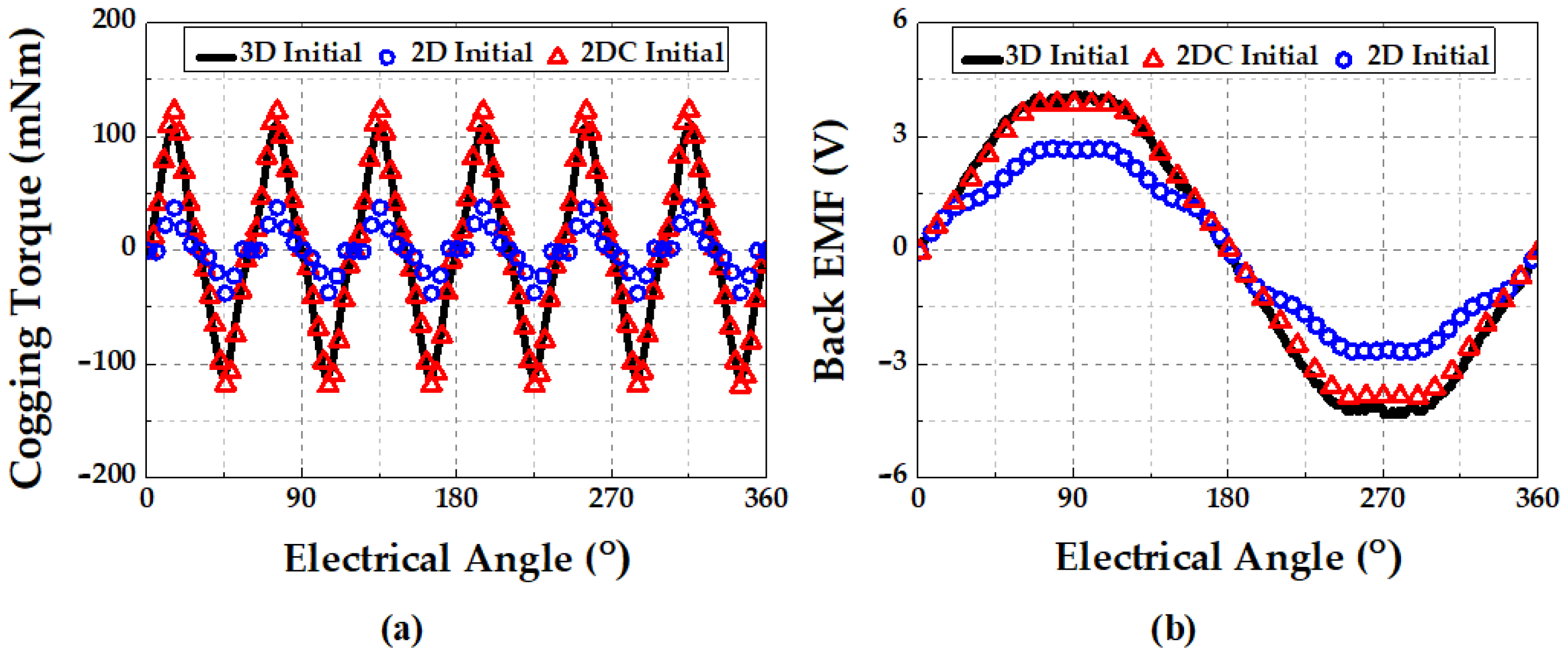
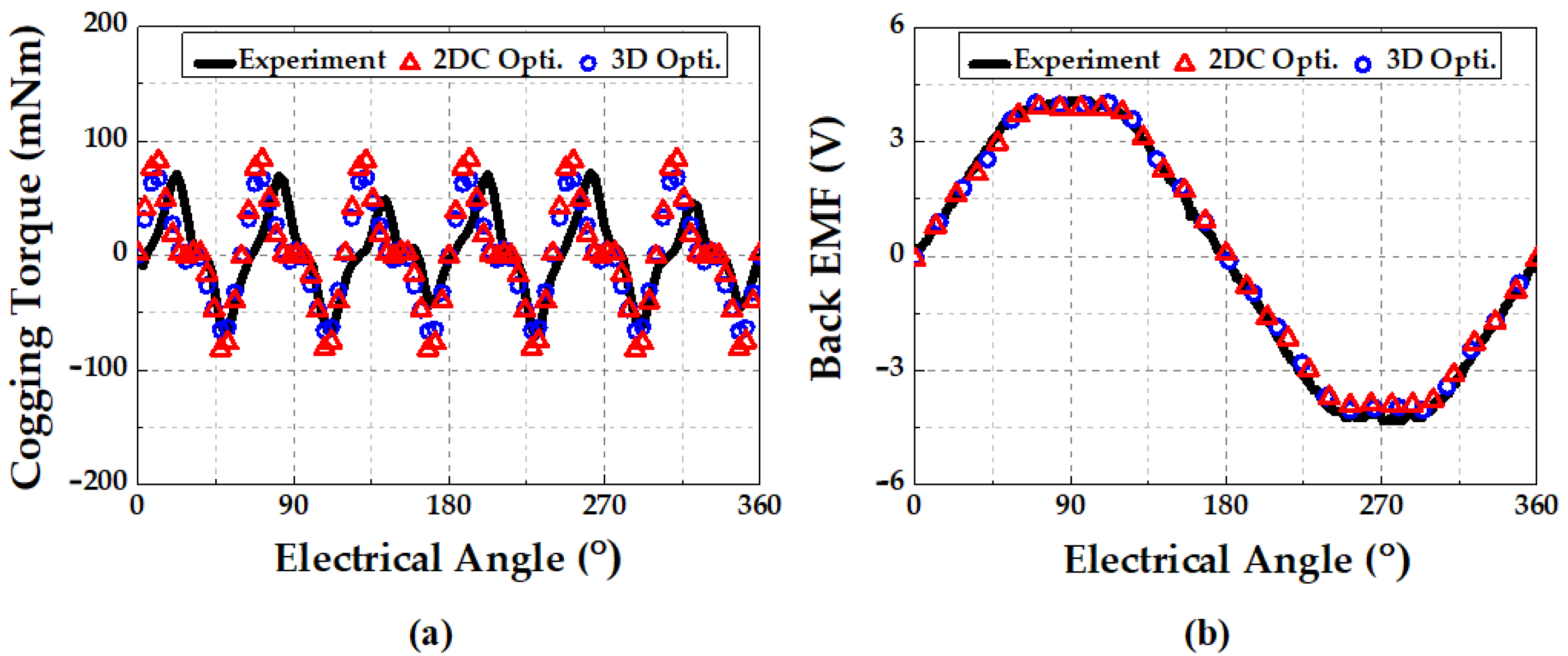
| Variables | Lower Limit | Upper Limit |
|---|---|---|
| PM Offset | 1 mm | 2 mm |
| Stator Offset | 4.5 mm | 6.5 mm |
| Tooth Width | 8.5 mm | 9.1 mm |
| Run | PM Offset (mm) | Stator Offset (°) | Tooth Width (mm) | Cogging Torque (mNm) | Back EMF (Vrms) |
|---|---|---|---|---|---|
| 1 | 1.20270 | 4.90540 | 8.62162 | 297.904 | 2.8869 |
| 2 | 1.79730 | 4.90540 | 8.62162 | 210.677 | 2.8488 |
| 3 | 1.20270 | 6.09460 | 8.62162 | 205.006 | 2.8602 |
| 4 | 1.79730 | 6.09460 | 8.62162 | 123.946 | 2.8224 |
| 5 | 1.20270 | 4.90540 | 8.97838 | 280.799 | 2.9078 |
| 6 | 1.79730 | 4.90540 | 8.97838 | 181.924 | 2.8687 |
| 7 | 1.20270 | 6.09460 | 8.97838 | 190.720 | 2.8794 |
| 8 | 1.79730 | 6.09460 | 8.97838 | 96.452 | 2.8408 |
| 9 | 1 | 5.5 | 8.8 | 258.151 | 2.8946 |
| 10 | 2 | 5.5 | 8.8 | 118.949 | 2.8295 |
| 11 | 1.5 | 4.5 | 8.8 | 273.221 | 2.8880 |
| 12 | 1.5 | 6.5 | 8.8 | 12.980 | 2.8415 |
| 13 | 1.5 | 5.5 | 8.5 | 228.151 | 2.8500 |
| 14 | 1.5 | 5.5 | 9.1 | 188.990 | 2.8835 |
| 15 | 1.5 | 5.5 | 8.8 | 206.225 | 2.8688 |
| Analysis Model | Initial Corrected Model | Optimal 2D Corrected Model |
|---|---|---|
| Phase Inductance | ||
| Flux Linkage |
| Load Torque (Nm) | Output Power (W) | Core Loss (W) | Copper Loss (W) | Efficiency (%) |
|---|---|---|---|---|
| 0.5 | 139.1 | 11.74 | 3.46 | 87.44 |
| 1 | 274.2 | 13.31 | 12.32 | 88.71 |
| 1.5 | 408.9 | 14.64 | 25.88 | 88.25 |
| 2 | 548.0 | 16.10 | 44.60 | 87.33 |
| 2.42 | 669.7 | 17.65 | 64.59 | 86.39 |
| Load Torque (Nm) | Output Power (W) | Core + Mechanical Loss (W) | Copper Loss (W) | Efficiency (%) |
|---|---|---|---|---|
| 0.5 | 137 | 25.4 | 3.91 | 82.76 |
| 1 | 274 | 27.3 | 12.34 | 88.05 |
| 1.5 | 411 | 33.7 | 26.18 | 88.28 |
| 2 | 548 | 44.1 | 45.92 | 87.17 |
| 2.38 | 651 | 54.2 | 64.81 | 87.58 |
| 2D Corrected Model | 3D Model | |
|---|---|---|
| No-load analysis (s) | 71 | 39,381 |
| Load analysis (s) | 5891 | 142,958 |
| Mesh | 10,253 | 809,367 |
| CPU | Intel Core i9-11900K @3.50 GHz | |
| RAM | 128 GB | |
| Cores | 4 of 8 | |
Publisher’s Note: MDPI stays neutral with regard to jurisdictional claims in published maps and institutional affiliations. |
© 2022 by the authors. Licensee MDPI, Basel, Switzerland. This article is an open access article distributed under the terms and conditions of the Creative Commons Attribution (CC BY) license (https://creativecommons.org/licenses/by/4.0/).
Share and Cite
Jo, S.-T.; Shin, H.-S.; Lee, Y.-G.; Lee, J.-H.; Choi, J.-Y. Optimal Design of a BLDC Motor Considering Three-Dimensional Structures Using the Response Surface Methodology. Energies 2022, 15, 461. https://doi.org/10.3390/en15020461
Jo S-T, Shin H-S, Lee Y-G, Lee J-H, Choi J-Y. Optimal Design of a BLDC Motor Considering Three-Dimensional Structures Using the Response Surface Methodology. Energies. 2022; 15(2):461. https://doi.org/10.3390/en15020461
Chicago/Turabian StyleJo, Seong-Tae, Hyo-Seob Shin, Young-Geun Lee, Ji-Hun Lee, and Jang-Young Choi. 2022. "Optimal Design of a BLDC Motor Considering Three-Dimensional Structures Using the Response Surface Methodology" Energies 15, no. 2: 461. https://doi.org/10.3390/en15020461
APA StyleJo, S.-T., Shin, H.-S., Lee, Y.-G., Lee, J.-H., & Choi, J.-Y. (2022). Optimal Design of a BLDC Motor Considering Three-Dimensional Structures Using the Response Surface Methodology. Energies, 15(2), 461. https://doi.org/10.3390/en15020461







